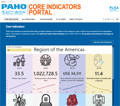
Anguilla - Country Profile
The Health in the Americas+ country profiles are based on the interagency indicators available as of the dates referenced. In some cases, the values of the indicators may differ from the most recent data available in the country.
Environmental and social determinants of health
In 2000 the total population of Anguilla was 11 177 inhabitants; by 2024 this figure had risen to 14 598, representing a 30.6% increase. Regarding the country’s demographic profile, in 2024 people over 65 years of age accounted for 12.5% of the total population, an increase of 5.4 percentage points compared to the year 2000. In 2024, there were 105.8 women per 100 men and 76.5 older people (65 years or older) per 100 children under 15 years of age, as can be seen in the country’s population pyramids, distributed by age group and sex (Figure 1). Considering the population between 15 and 64 years of age to be potentially active (i.e., potential participants in the labor force), this group represented 71.2% of the total population of the country in 2024 ( 10 387 people). When we add these figures to the potentially passive population (2 387 under 15 years of age and 1 826 over 65 years of age), the result is a dependency ratio of 40.6 potentially passive people per 100 potentially active people. This ratio was 54.7 in 2000.
Life expectancy at birth in 2024 was 79.5 years, higher than the average for the Region of the Americas and 4.4 years higher that in 2000 (75.1).
Figure 1. Population pyramids, years 2000 and 2024
The literacy rate was in 2020 95.7% for men and 95.4% for women, in 2001, the average number of years of schooling in Anguilla was of 10.5 years, this is the latest year for which information is available.
The health situation
Maternal and child health
In 2022 the infant mortality in was 0. The percentage of low-weight births (less than 2500 g) decreased from 6.5% to 5.6% between 2002 and 2022.
Regarding the immunization strategy, measles vaccination coverage was 86.0% in 2022, a decrease of 13 percentage points from 2000.
The maternal mortality ratio for zero for 2021, the latest information available (Figure 5). In relation to fertility, it is estimated that in 2024 women had an average of 1.4 children throughout their reproductive lives. In the specific case of adolescent fertility, there was a 49.1% decrease, from 55.0 live births per 1000 women aged 15 to 19 years in 2000 to 28.0 in 2024. In 2022, 100% of births were attended by skilled birth personnel. In the period between 2010 and 2012, there was no variation in the percentage of prenatal care, which remained at 100%.
Figure 4. Infant mortality per 1000 live births, 2001–2022
Communicable diseases
In 2022, there were 6 new cases of tuberculosis per 100 000 population in Anguilla. In 2022, the estimated human immunodeficiency virus (HIV) infection incidence rate (new diagnoses) was 7.1 per 100 000 population.
Noncommunicable diseases and risk factors
In Anguilla, the prevalence of tobacco use among people aged 15 and older was 5.8% in 2016. In the same age group, the prevalence of overweight and obesity was 70.1% in 2016.
Also in 2016, 34.9% of the population reported insufficient physical activity.
The sources of the interagency indicators used in this profile can be found in this table.
 For the latest data on health indicators for the Region of the Americas, be sure to visit the PAHO Core Indicators portal.
For the latest data on health indicators for the Region of the Americas, be sure to visit the PAHO Core Indicators portal.
COUNTRY/TERRITORY PROFILES
Anguilla
Antigua and Barbuda
Argentina
Aruba
Bahamas
Barbados
Belize
Bermuda
Bolivia
Bonaire, Sint Eustatius, and Saba
Brazil (English) (Português)
Canada
Cayman Islands
Chile
Colombia
Costa Rica
Cuba
Curaçao
Dominica
Dominican Republic
Ecuador
El Salvador
French Guiana, Guadeloupe and Martinique
Grenada
Guatemala
Guyana
Haiti (English) (Français)
Honduras
Jamaica
Mexico
Montserrat
Nicaragua
Panama
Paraguay
Peru
Puerto Rico
Saint Kitts and Nevis
Saint Lucia
Saint Vincent and the Grenadines
Sint Maarten
Suriname
Trinidad and Tobago
Turks and Caicos Islands
United States of America
Uruguay
Venezuela
Virgin Islands (British)
Virgin Islands (U.S.)


